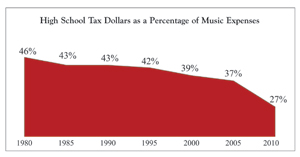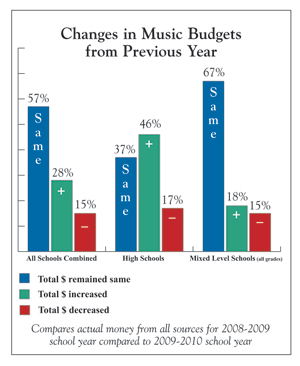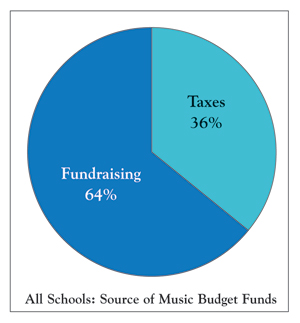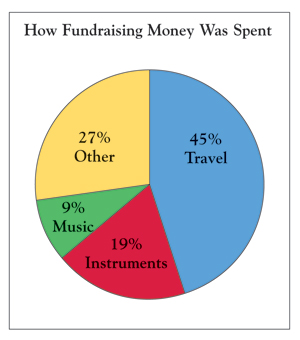![]()
The 2010 survey of instrumental music budgets does not reflect the ongoing recession in the economy. Combining the results of all schools responding to this survey, over half showed unchanged budgets when tax and fundraising money are combined, and more schools showed an increase in this total than a decrease (schools with less than $1,000 difference from the previous year are treated as unchanged). The amount of tax money from school boards was flat at 76% of schools, with 12% showing an increase and 12% a decrease. On the fundraising side of the equation, 65% of all schools raised the same amount as the year before, 27% were up and only 8% raised less money than in the year before.
What is distressing is the trend toward an even lower percentage of music budgets coming from tax money. In 1977, the first year we surveyed school budgets, there was a slight dominance of tax over fundraising. In almost every year since then the ratio has shifted toward more fundraising than tax money. This past year only 36% of the money spent on the instrumental music programs came from the school board and 64% from fundraising. At the high school level the ratio was 27% from taxes and 73% of expenditures, other than teacher’s salaries, came from fundraising and such other sources as donations, ticket sales, and fundraising projects.
One of the more surprising results of the survey was an 8% increase in music participation in a year when school enrollment was flat. Directors anticipate flat school enrollments for next year and higher music participation. A word of caution is that the survey is sent only to Instrumentalist subscribers, who are typically the more active school music teachers. The surveys also will not reflect schools where music programs have been eliminated or sharply curtailed. The average director responding to the survey has 9 years of teaching experience and sees approximately 93 students each week.

High School Budgets: Participation in high school music programs rose 7% in 2009-10, and overall school enrollment rose 2% at schools responding to this survey. High school directors predict steady music enrollment in the coming year but a decline in direct funding from school districts of nearly 20% in 2010-11. However, because 73% of the expenditures for high school music programs is raised through fundraising, ticket sales, and contributions, the budgets of many ensembles depend upon vigorous fundraising in a tough economy.
Multi-Level Schools: Directors in districts that cover elementary through high school students report that school enrollment declined slightly and music participation rose a bit. Spending at these schools increased 3% during the 2009-10 school year. There was a 2% increase in school support and a 3% rise in fundraising. These directors predict a slight decline in spending for the 2010-11 school year, which over the years of the survey has proven to be a typically pessimistic estimate that often does not come to pass.

Comments from Directors
The survey asked directors to assess the impact of the economy on their programs and the prospects for the future.
High School Directors
California: As the economy worsens and the housing market goes up and down, people have moved away from our area for work and cheaper housing. The student population is changing toward a lower economic status.
Georgia: The assistant band director position was cut for the 2009-10 year and not reinstated. Our budget from the school system was cut 20% for 2009-10 but may increase slightly this year.
North Carolina: We have continued to raise money – more than ever. However, soliciting ads for programs has been difficult.
Arkansas: The school is now unwilling to help me continue with incentive programs that have existed for 20 years (trips and picnics). The budget was cut three years ago (it had been the same for fifteen years). Directors have been shifted around to fill non-band music positions.
Wisconsin: Our school has a 63% free and reduced lunch rate, and we are the only high school in our county. My students are playing on instruments that aren’t maintained. They can’t afford reeds and buying gas to drive into school for pep band is a hardship (we have a 500 square mile radius in our district). Also our enrollment is dwindling because there are no jobs in the area and families must leave to find work.
Washington: I have received less financial support for each of the past few years from both my building and activities budgets. This directly correlates to the reduction in state and federal money the district has received.
California: We have made minor cuts in our booster funded staffing (reducing concert band coaches to 9 months instead of 10) and not taking the marching band to an out-of-area regional. Most drastic is the reduction of our day from seven periods to six. This has had a huge impact on orchestra and choir but not band.
Elementary and Middle School Directors
Indiana: The economy has been devastating – individual socioeconomic status among students has dropped tremendously. Free and reduced lunch for students has increased from 28% to 73% in this school. Staff is stretched to the limit. The program has grown consistently since the school opened in 2004 but no additional money has been available to provide adequate staffing. We do not fundraise, but rely instead on donations from parents and the PTO. The PTO contribution is now only 50% of what it was in 2004, and parent donations are down as well.
New Jersey: For next year the new governor has decreased all state aid to all public schools by 28%. This has been a disaster for all music programs in this state.
Maryland: I’ve been cut to three days of band and two days of general music. We have no sectionals anymore. How do they expect me to do it?
Colorado: Our school budget was $6,000 in 2007-08, $3,000 in 2008-09, and $1,500 in 2009-10, We get no budget this year will have to ask the principal for anything.

Multi-Level School Directors
Wisconsin: This private school has been hit very hard. Tuition has to go up, enrollment is going down, and the school is challenged to try to market itself without the money to do it. Our fine arts boosters keep us current on finances. Without the boosters we would really be hurting just to attend a festival.
Minnesota: Few beginners can afford to rent or purchase an instrument. My collection of old beaters is tapped out, and I can’t fix them, let alone purchase new horns.
Pennsylvania: We are now expected to have booster organizations supply instruments as well as pay the cost of sending students and directors to state festivals.
Oregon: Students have trouble paying band fees and fewer upgrade their instruments. The price of reeds is hurting a lot.
Ohio: Our fundraisers have all been down by as much as 20% in the last two years.
Nebraska: Large cuts lie ahead. We have made provisions to operate on almost no budget for the coming few years.
Ohio: More students are unable to rent or purchase instruments. Not all of my students were able to take the biannual trip to Washington, D.C. or Florida.
Michigan: The budget has been cut by 15% in the last two years. We used to go to more marching competitions, and now it has been cut to one.
Missouri: Our school has been hurt very badly. We’ve had to RIF a few people, including a principal. We’ll have to pay for any trips now.
Wisconsin: While we have been fortunate and dodged the bullet of cuts, we see many changes resulting from the economy and school funding. The demographic of students is changing. More students than ever before need instruments to play in band. Budgets are reduced annually. We rely on fundraising more than ever to provide a comprehensive band program. We look for horns at garage sales, purchase them ourselves, and get them repaired for students to use. For the forseeable future, we will be looked at for staff reductions.
Nebraska: It has made fundraising more of a chore. My budget needs to be more precise than ever before.
Fundraising Experiences
Directors share their successful and memorable fundraising experiences.

High Schools
Georgia: Fruit – $8,000, Soda sales – $5,000, Concessions at football games $7,000, Band participation fee $18,000 ($100 per student)
California: We hold an annual black-tie fundraiser and auction, with dinner and jazz. It nets approximately $35,000-$40,000 a year. We choose to have one large fundraiser and avoid asking students to sell more stuff. I am from Michigan but teach in California. I donate my services to make an authentic Midwestern dinner. This year two parents got into a bidding war, and we raised $1,400 for a meatloaf dinner.
Washington: Events like a pre-concert dinner have been very successful. Typically we raise about $6-8 per ticket sold, yielding $600-800 per event. Also, our annual raffle is highly lucrative and earns between $3,000 and $6,000 on average.
Illinois: Our best fundraisers are tag days when we solicit donations at community businesses. We stand outside in our uniforms and hold milk jugs to collect money. Each donor receives a lollipop.
Tennessee: An annual golf scramble averages $10,000 per year, but that figure was down this year. Car washes usually raise about $500.
Multi-Level Schools
Missouri: We made a $400 profit on a Guitar Hero tournament, which cost almost nothing. We charged a $5 participation fee, $2 observer fee, and raised additional funds from concessions. The top two winners received prizes.
Louisiana: One year we sold pizzas that had to be kept cold, but the refrigeration unit in the delivery truck was turned off because the delivery driver stopped off to visit his girlfriend before delivering our product. He was fired. We provide a concessions stand for 29 athletic events per year with help from volunteer and raise about $6,000 per year average from 35% profit margin.
Iowa: We negotiate contracts with wholesalers and have pricing agreements to help keep our costs lower. Our most memorable experience was serving a crowd of 2,000 fans at a playoff game with just 9 workers.
Wisconsin: For the kickoff for one of our pizza fundraisers the rep brought in ovens to bake pizzas for the kids to sample. By the time class was starting after 1.5 hours of trying to cook pizzas, we had blown every fuse in our section of the building and the superintendent was considering closing school because many rooms had no lights (or windows). Ultimately it was a banner sale that raised over $5,000. Students thought it was a hoot.
Wisconsin: We hold a citrus fruit and fudge fundraiser in the fall that raises about $2,000 profit. A cheesecake fundraiser in the spring also makes a $2,000 profit.
Nebraska: We prefer events that involve community service. Door-to-door sales are a waste of time because too many other groups sell the same things. I prefer events that offer people an opportunity to work alongside of and observe the hard work of band students.
Minnesota: All of our fundraising goes towards trips. I learned the hard way about accounting and billing errors when I made several mistakes as a rookie. Since then I have developed better systems.
Michigan: We held a raffle for a $10,000 truck and raised $20,000 by selling $10 tickets. Many people bought 10 tickets for $100. On the day of the drawing we let customers get one ticket free for every ten they bought. We had a Marine draw the winner, and there was total silence as we announced the winner.
Montana: One time we had some unrepairable instruments in the back room, and I decided to have an instrument throw. For $5 customers got the opportunity to throw an instrument. The person who threw it the farthest got to keep the horn.
Indiana: We fell flat on our faces with a discount card fundraiser. The band and choir went in together and purchased 1,000 cards and could not sell enough to pay the bill. This fundraiser combined a bad idea with bad timing.
Pennsylvania: Sandwich sales are the easiest. We buy really cheap and make $2 profit on each. We also volunteer our services at a carnival parking cars and receive about $4,000 for a few hours of work.
Changes in School Policies and Schedules
Wisconsin: We are on a modified block schedule, and I lose several juniors and seniors each year because the concert band rehearses at the same time as AP English, journalism, and medical terminology classes. I don’t fault students for wanting to take advanced classes, but in a small school there is only one course offering for each of these subjects, and students are forced to take the academics. I still let them play in band and usually work something out with the other teacher so that they can come to band one day a week. This the only way I can keep some of my more experienced players.
Georgia: The curriculum has gotten so involved that students have little room in the schedule to fit band or any other elective into a six-period day.
DC: Multiple music classes are scheduled at the same time and older facilities are not soundproof enough to block out the sound of loud groups.
Tennessee: The administration is trying to add as many AP classes as possible to a 4×4 block. Most band students want to take honors classes, which makes it very hard to put together a workable schedule. The state has increased graduation requirements, and music is not included in the increase.
Arkansas: Students now only have one or two elective periods and more elective choices. They are less likely to be able to stay in band once they decide to join. No Child Left Behind plus the school’s International Baccalaureate program have drastically reduced the number of band students. The top and bottom students can no longer stay in band, and we are left with the average students.
Oregon: Block schedule and the IB program rip our best players from our top group in the junior and senior years. I have the top clarinet player in the state in my band this year, but he will not be able to take wind ensemble next year because of schedule conflicts.
Washington: Two years ago the school changed from a 4-period block where I saw my students every day for 85 minutes, to a regular 6-period day (55 min. classes). The result is that I have 3 concerts now, instead of 4, the level of musicians/complexity in the music is diminished. Some scheduling problems were resolved, but new scheduling problems have taken their place.
North Carolina: A/B schedule at the middle school has put my freshman students a grade level behind where they were in musical ability before the change.
Illinois: A reduction in teachers has produced larger class sizes and changes in the master schedule. This reduces the number of band and orchestra sectionals.
Mississippi: We’ve lost .8 music staff from our peak. Now our high school band director is .4 middle school music and .6 high school, and I teach some grade 5 students in addition to my instrumental duties.





